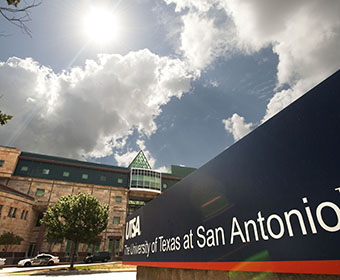
(March 20, 2019) -- The UTSA Master of Architecture and the Master of Science in Architecture have been awarded a unique science, technology, engineering and mathematics (STEM) designation by the Texas Higher Education Coordinating Board. UTSA is now the only Texas institution—and one of few universities in the nation—to have STEM CIP Code 04.0902 for its M. Arch. and M.S. in Architecture programs.
The Classification of Instructional Programs or “CIP Code” is a government-developed designation for academic programs, according to the primary subject matter of the programs’ content. CIP Codes help students identify areas of study with particular curricular emphases as well as programs that offer added benefits such as funding and visa status.
The new CIP Code will help UTSA recruit high-caliber students who want access to STEM-related architecture opportunities. It will also provide UTSA faculty members with the opportunity to compete for new types of research funding.
“Having both of our graduate programs recognized with the new STEM CIP Code will create a wide range of opportunities,” said Sedef Doganer, professor and chair of the UTSA Department of Architecture. “This new STEM designation positions UTSA Architecture at the forefront of the discipline and will allow us to break new ground in preparing students for success through architectural research, education and practice.”
The designation provides an additional 24 months of Optional Practice Training (OPT) for international students, with a total of 36 months of OPT employment after degree completion. This enhances opportunities for international students to secure work visas at the end of their educational journey.
The UTSA Department of Architecture has historically included STEM-related content in its program offerings. Additionally, many architecture faculty at UTSA conduct STEM-related research. As a result, UTSA’s M. Arch. and M.S. in Architecture graduates are prepared to develop design intentions and ideas with sound, research-based solutions.
“UTSA has always employed an applied STEM approach to both our architectural education and our professional practice,” said John Murphy, dean of the UTSA College of Architecture, Construction and Planning. “This new CIP Code is a validation of our efforts to differentiate our curriculum with a STEM emphasis.”
Research and development are crucial in improving and developing key concepts related to sustainability and problem solving for the user groups architects serve. In addition to applying advanced technologies and sustainable principles to building design and construction, architects lead multidisciplinary teams of designers, engineers and consultants to effectively integrate building systems and improve the public health and welfare.
In July of 2018, the United States Congress passed the Carl D. Perkins Career and Technology Education (CTE) Act, making architecture an officially recognized STEM subject. The bi-partisan act will allow states to use federal funds to modernize the CTE curriculum, allowing for an increase in available funds for high-school-level architectural education. The American Institute of Architects (AIA) lobbied for the change for several years, in the meantime bringing design to K-12 students through special programs and activities. The bill formalizes these efforts.
Learn more about the UTSA College of Architecture, Construction and Planning.
Celebrate UTSA’s 50th Anniversary and share social media posts about the 50th using the hashtag #UTSA50.
Connect with UTSA online at Facebook, Twitter, YouTube, Instagram and LinkedIn.
UTSA Today is produced by University Communications and Marketing, the official news source of The University of Texas at San Antonio. Send your feedback to news@utsa.edu. Keep up-to-date on UTSA news by visiting UTSA Today. Connect with UTSA online at Facebook, Twitter, Youtube and Instagram.
Have questions about making your OER accessible on UTSA Pressbooks? The OER Team and the Digital Accessibility are ready to answer them! Bring your questions about OER and accessibility and receive guidance from our two teams.
Virtual Event (Zoom)In this workshop, attendees will be introduced to Pandas, a Python tool for working with data easily. It makes it simple to organize and analyze information when data is organized and categorized, like spreadsheets or tables.
Group Spot B, John Peace LibraryDía en la Sombrilla, formerly Fiesta UTSA, is a festival hosted each spring as a part of Fiesta® San Antonio events. Sponsored by Roadrunner Productions, the event features music, food, confetti, games, event t-shirts, and more.
Sombrilla Plaza, Main CampusCovidence is a systematic & scoping review tool used to streamline the process of screening and reviewing articles. Using this software, research teams can easily import studies, perform automatic deduplication, and extract data using templates. This workshop will show attendees how to start a review in Covidence, add collaborators, and get started on screening.
Virtual (Zoom)In this workshop, attendees will be introduced to Pandas, a Python tool for working with data easily. It makes it simple to organize and analyze information when data is organized and categorized, like spreadsheets or tables.
Group Spot B, John Peace LibraryEach fall and spring semester, students convene at the Main Campus at UTSA with booths, ideas and prototypes. A crowd of judges, local organizations, students, faculty and sponsors walk around and talk to the students about their projects and ask questions. Students get the real-life experience of "pitching" their project with hopes of getting funding or support to move to the next level.
UTSA Convocation Center, Main CampusJoin the doctoral candidates for the Doctoral Conferreal Ceremony and celebrate their accomplishments.
Arts Building Recital Hall, Main CampusThe University of Texas at San Antonio is dedicated to the advancement of knowledge through research and discovery, teaching and learning, community engagement and public service. As an institution of access and excellence, UTSA embraces multicultural traditions and serves as a center for intellectual and creative resources as well as a catalyst for socioeconomic development and the commercialization of intellectual property - for Texas, the nation and the world.
To be a premier public research university, providing access to educational excellence and preparing citizen leaders for the global environment.
We encourage an environment of dialogue and discovery, where integrity, excellence, respect, collaboration and innovation are fostered.